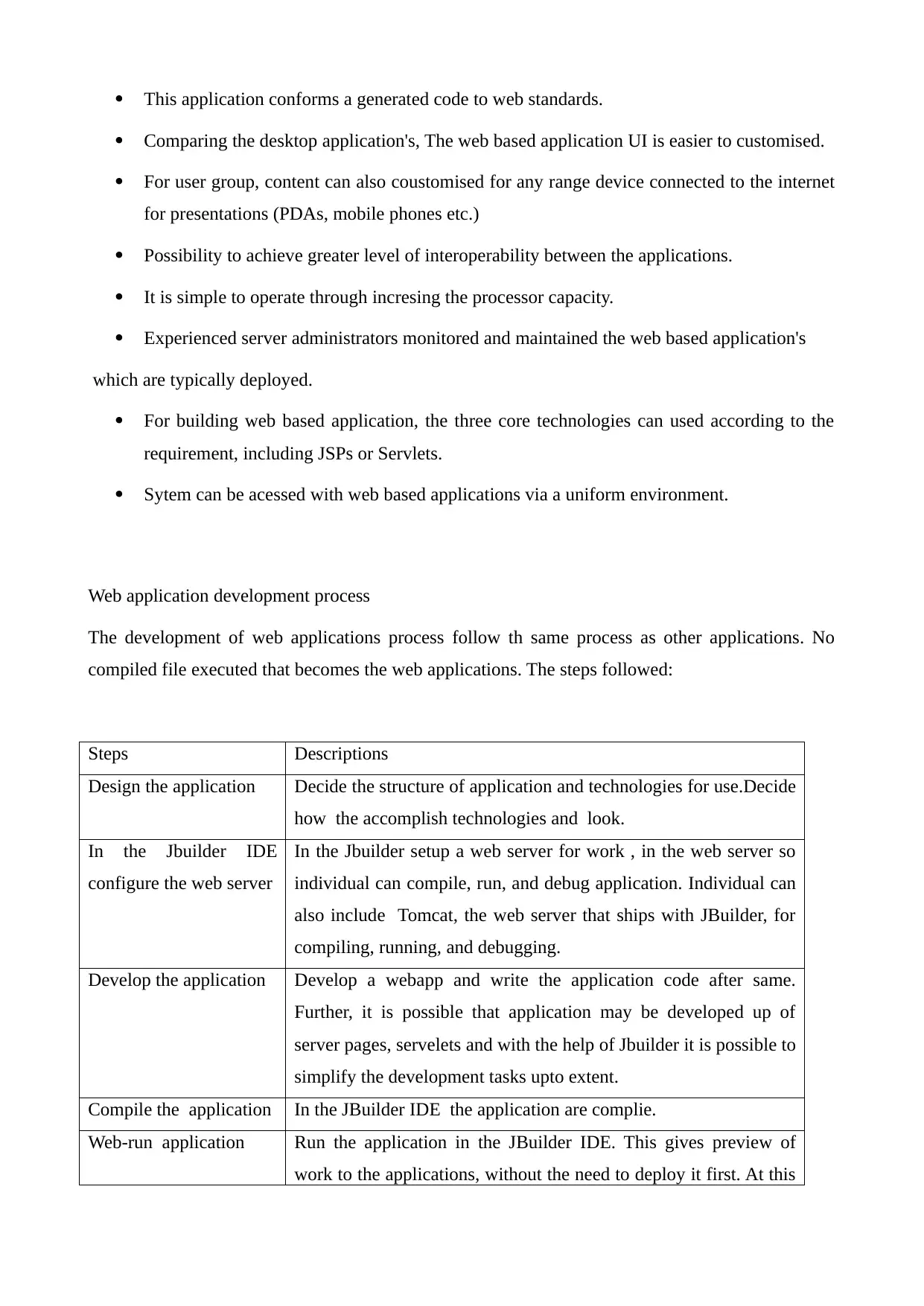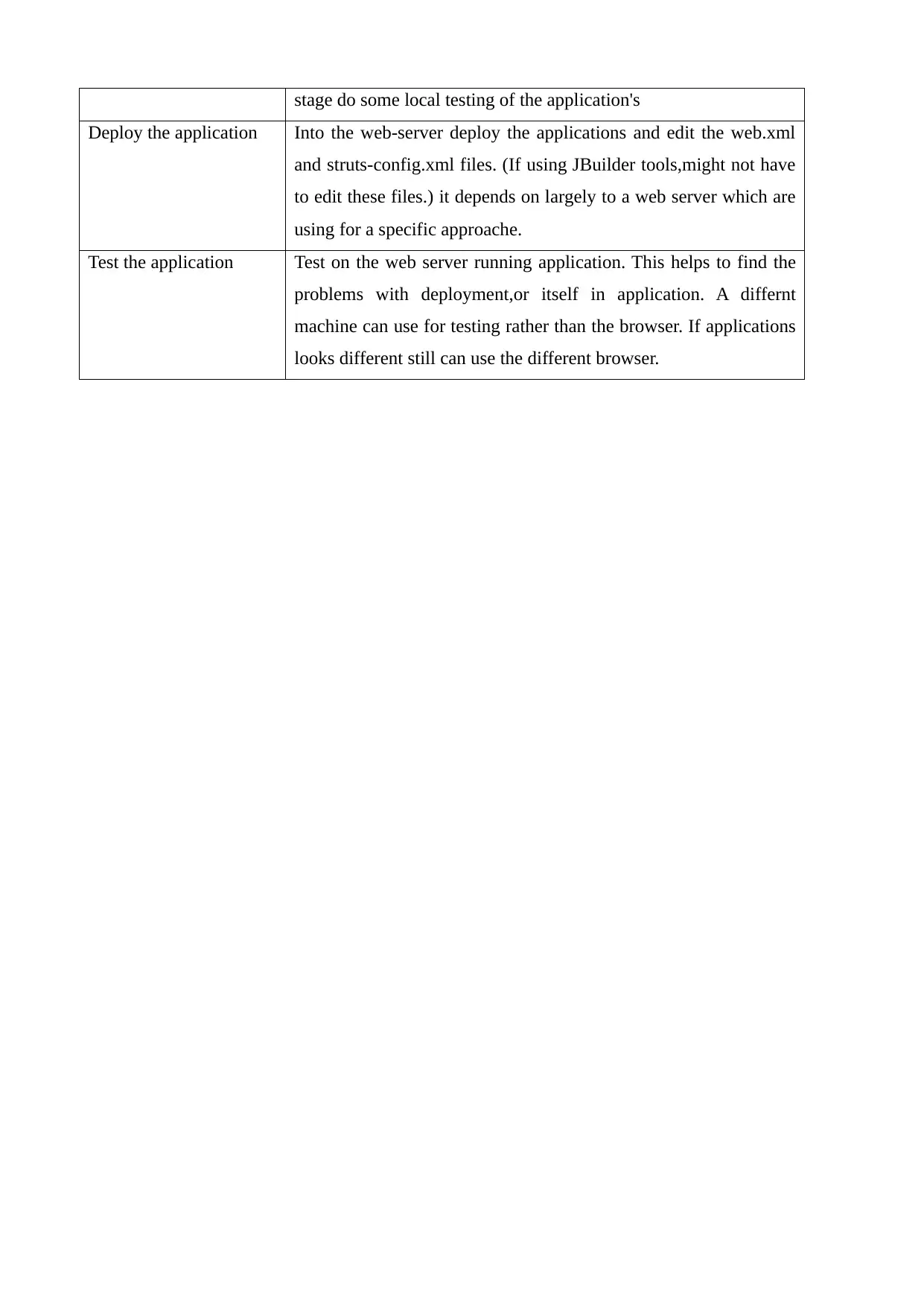Web Application Technologies: Applets Advantages & Development
VerifiedAdded on 2023/04/21
|3
|806
|486
Report
AI Summary
This report discusses the advantages of using applets in web application development, highlighting their ability to provide easier user interfaces compared to Servlets or JSPs, offload processing from the server, and perform client-side data validation. It also provides an overview of various web technologies such as JSP, Servlets, and JSTL, emphasizing their roles in server-side processing, platform independence, and data awareness. The report further outlines the web application development process, detailing the steps involved in designing, developing, compiling, deploying, and testing web applications using tools like JBuilder IDE. It concludes by noting the increasing customization options and interoperability offered by web-based applications compared to desktop applications.

Advantage of Applets:
Servlets or JSPs can be easier user interfaces compare to the Applets.
Applets can download and run, the server need not to support the Java application. This can
be useful if a company write web application, they don't have control over server-side.
Applets used for data validation,instead of validating server-side. JavaScript provide a
conjuction between the Applet and the Servlet or JSPs.
It reduces the numbers from browser to the server side at intial, since proceedings a lot
client machine.
Java applet perform fast and perform similar to the native software.
From a main routine( either in the applet's class or in a separate class) a developers can
directly debug an applet.
It ia independent platwork, they works with all the operating system.
Tehnology use in web application's:An overview of the web technologies, emerging strategies for
application software is to access to software previously distributed as a local application's.
The tips helps to make decisions.
JSP or Servlet can use to do a lot of server-side processing.
From the servlet or JSPs avoid a lot of code and speed up application startup.
In case, any individual wants to control JDK version for application purpose, disabled Java
in browsers, individual can use Servlet or JSPs.
JSPs or servlet can use for replacement of CGI, with no overhead memory.
JSPs provide independent paltform, which is similar like an ASP.
Combination of JSPs or Servlet can incerase the complex, but provide an applet on client
side or servlet on server-side.
In JSPs or sevlet, Internetbeans Express provide data-aware.
At first look of JSTL routine necessary, for developing tag library like control structure, date
and number formatting.
Struts web application seperate the java code to the HTML.(JSPs or Servelts looks enough
similar and largely matter on personal preference). Combination of two or more web
applications will use these technologies.
Servlets or JSPs can be easier user interfaces compare to the Applets.
Applets can download and run, the server need not to support the Java application. This can
be useful if a company write web application, they don't have control over server-side.
Applets used for data validation,instead of validating server-side. JavaScript provide a
conjuction between the Applet and the Servlet or JSPs.
It reduces the numbers from browser to the server side at intial, since proceedings a lot
client machine.
Java applet perform fast and perform similar to the native software.
From a main routine( either in the applet's class or in a separate class) a developers can
directly debug an applet.
It ia independent platwork, they works with all the operating system.
Tehnology use in web application's:An overview of the web technologies, emerging strategies for
application software is to access to software previously distributed as a local application's.
The tips helps to make decisions.
JSP or Servlet can use to do a lot of server-side processing.
From the servlet or JSPs avoid a lot of code and speed up application startup.
In case, any individual wants to control JDK version for application purpose, disabled Java
in browsers, individual can use Servlet or JSPs.
JSPs or servlet can use for replacement of CGI, with no overhead memory.
JSPs provide independent paltform, which is similar like an ASP.
Combination of JSPs or Servlet can incerase the complex, but provide an applet on client
side or servlet on server-side.
In JSPs or sevlet, Internetbeans Express provide data-aware.
At first look of JSTL routine necessary, for developing tag library like control structure, date
and number formatting.
Struts web application seperate the java code to the HTML.(JSPs or Servelts looks enough
similar and largely matter on personal preference). Combination of two or more web
applications will use these technologies.
Paraphrase This Document
Need a fresh take? Get an instant paraphrase of this document with our AI Paraphraser

This application conforms a generated code to web standards.
Comparing the desktop application's, The web based application UI is easier to customised.
For user group, content can also coustomised for any range device connected to the internet
for presentations (PDAs, mobile phones etc.)
Possibility to achieve greater level of interoperability between the applications.
It is simple to operate through incresing the processor capacity.
Experienced server administrators monitored and maintained the web based application's
which are typically deployed.
For building web based application, the three core technologies can used according to the
requirement, including JSPs or Servlets.
Sytem can be acessed with web based applications via a uniform environment.
Web application development process
The development of web applications process follow th same process as other applications. No
compiled file executed that becomes the web applications. The steps followed:
Steps Descriptions
Design the application Decide the structure of application and technologies for use.Decide
how the accomplish technologies and look.
In the Jbuilder IDE
configure the web server
In the Jbuilder setup a web server for work , in the web server so
individual can compile, run, and debug application. Individual can
also include Tomcat, the web server that ships with JBuilder, for
compiling, running, and debugging.
Develop the application Develop a webapp and write the application code after same.
Further, it is possible that application may be developed up of
server pages, servelets and with the help of Jbuilder it is possible to
simplify the development tasks upto extent.
Compile the application In the JBuilder IDE the application are complie.
Web-run application Run the application in the JBuilder IDE. This gives preview of
work to the applications, without the need to deploy it first. At this
Comparing the desktop application's, The web based application UI is easier to customised.
For user group, content can also coustomised for any range device connected to the internet
for presentations (PDAs, mobile phones etc.)
Possibility to achieve greater level of interoperability between the applications.
It is simple to operate through incresing the processor capacity.
Experienced server administrators monitored and maintained the web based application's
which are typically deployed.
For building web based application, the three core technologies can used according to the
requirement, including JSPs or Servlets.
Sytem can be acessed with web based applications via a uniform environment.
Web application development process
The development of web applications process follow th same process as other applications. No
compiled file executed that becomes the web applications. The steps followed:
Steps Descriptions
Design the application Decide the structure of application and technologies for use.Decide
how the accomplish technologies and look.
In the Jbuilder IDE
configure the web server
In the Jbuilder setup a web server for work , in the web server so
individual can compile, run, and debug application. Individual can
also include Tomcat, the web server that ships with JBuilder, for
compiling, running, and debugging.
Develop the application Develop a webapp and write the application code after same.
Further, it is possible that application may be developed up of
server pages, servelets and with the help of Jbuilder it is possible to
simplify the development tasks upto extent.
Compile the application In the JBuilder IDE the application are complie.
Web-run application Run the application in the JBuilder IDE. This gives preview of
work to the applications, without the need to deploy it first. At this

stage do some local testing of the application's
Deploy the application Into the web-server deploy the applications and edit the web.xml
and struts-config.xml files. (If using JBuilder tools,might not have
to edit these files.) it depends on largely to a web server which are
using for a specific approache.
Test the application Test on the web server running application. This helps to find the
problems with deployment,or itself in application. A differnt
machine can use for testing rather than the browser. If applications
looks different still can use the different browser.
Deploy the application Into the web-server deploy the applications and edit the web.xml
and struts-config.xml files. (If using JBuilder tools,might not have
to edit these files.) it depends on largely to a web server which are
using for a specific approache.
Test the application Test on the web server running application. This helps to find the
problems with deployment,or itself in application. A differnt
machine can use for testing rather than the browser. If applications
looks different still can use the different browser.
⊘ This is a preview!⊘
Do you want full access?
Subscribe today to unlock all pages.

Trusted by 1+ million students worldwide
1 out of 3
Related Documents
Your All-in-One AI-Powered Toolkit for Academic Success.
+13062052269
info@desklib.com
Available 24*7 on WhatsApp / Email
![[object Object]](/_next/static/media/star-bottom.7253800d.svg)
Unlock your academic potential
Copyright © 2020–2025 A2Z Services. All Rights Reserved. Developed and managed by ZUCOL.





